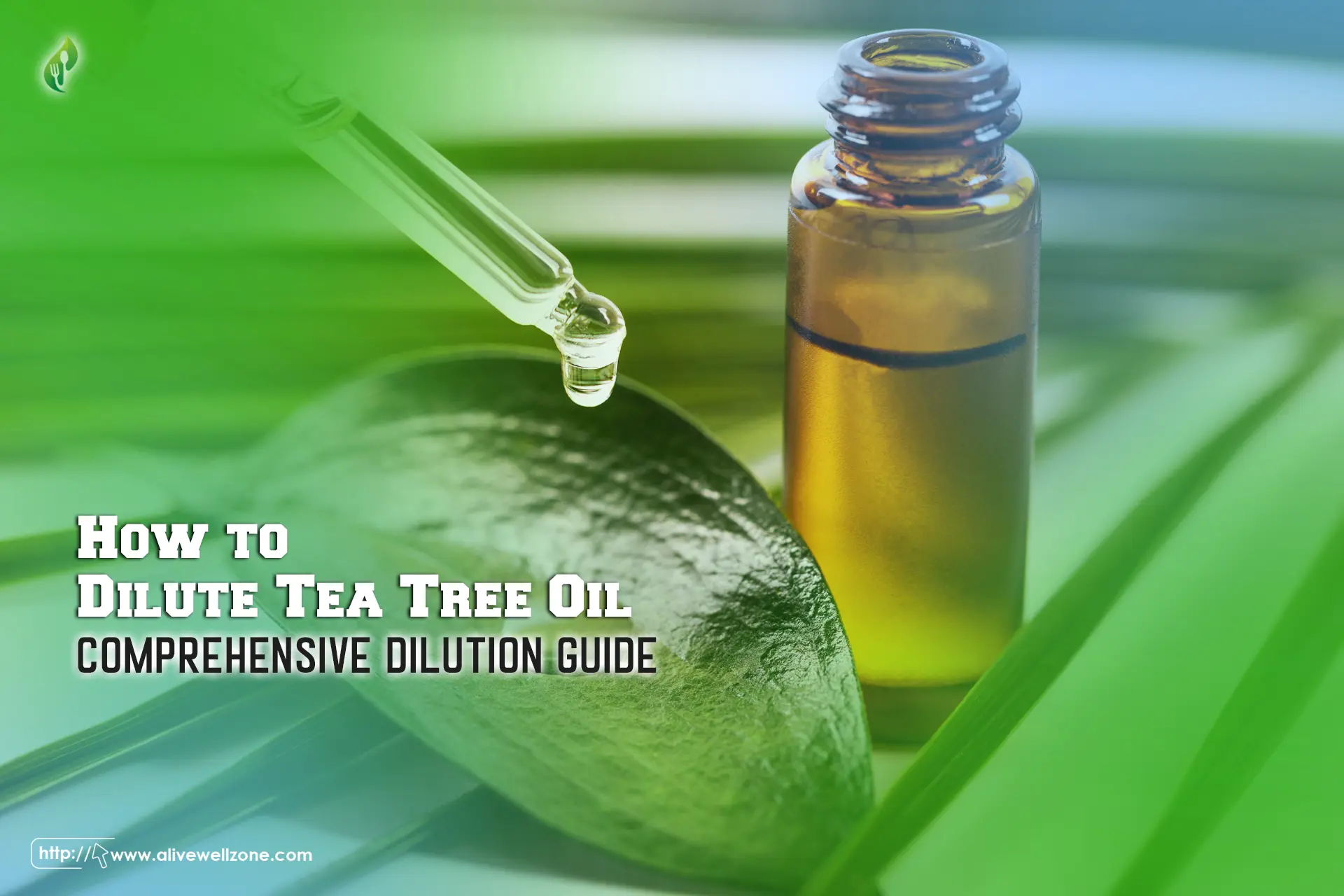
Last Updated on December 5, 2024 by Helena Akter
Tea tree oil, often dubbed the “elixir from Down Under,” is a gem that Mother Nature concealed in the leaves of a tree. This golden liquid isn’t just another essential oil; it’s a powerhouse of antiseptic properties. Now, that makes it a unique standout in the field of natural remedies.
Besides, its versatility ranges from treating acne to refreshing homes, earning it a special spot in many households and beauty routines. With such a potent profile, understanding how to dilute tea tree oil becomes paramount to reap its benefits safely.
Let’s dive into this guide and learn how to dilute this remarkable oil, ensuring you reap its benefits without a hitch.
What is Tea Tree Oil?
Tea tree oil is derived from the Australian Melaleuca alternifolia tree leaves. Contrary to its name, it’s unrelated to the tea we drink. Consuming it is dangerous as it’s toxic when ingested.
This tree, which can grow over 25 feet tall, is native only to Australia. Its oil was first documented in the 1920s in Australia for its antibacterial properties. During World War II, Australian soldiers even had it in their kits as an antibiotic.
Its popularity then expanded to various European countries. Today, large plantations in Queensland, Western Australia, and New South Wales cultivate it. Plus, the oil has a unique woody aroma and is found in many topical products like creams and salves.
Precautions Before Applying Tea Tree Oil
Tea tree oil can be effective, especially when diluted correctly with a carrier oil. However, as skin reactions vary, you better test it before extensive use.
Patch Test
Apply a small amount inside your forearm and seal with a bandage for 24 hours. If symptoms like redness or itchiness appear, remove them immediately.
Post-Patch Test
If no allergic reactions are observed after 24 hours, you’re generally safe to use the oil.
Dilution Ratio
Ensure your mixture consists of 3% tea tree oil and 97% carrier oil. For those wondering how to dilute tea tree oil with coconut oil, this ratio remains consistent.
Caution
Stick to the recommended ratio even if the patch test is clear, as higher concentrations might lead to skin sensitivity.
How To Dilute Tea Tree Oil?
Tea tree oil is a multifunctional essential oil with numerous benefits, especially for skin treatments and aromatherapy. Given its potency, it’s crucial to dilute it properly to avoid skin irritation.
Here’s a concise guide on how you can do it —
- Prepare Your Tools: You’ll need a carrier oil, a mixing container or bottle, and a dropper.
- Select a Carrier Oil: Carrier oils, like coconut, olive, jojoba, grape seed, or almond oil, help dilute and maintain the benefits of essential oils.
- Decide on Concentration: Typically, a 1-5% dilution is safe for skin applications.
- Patch Test: Before broad application, test the diluted oil on a small skin area to detect any allergic reactions.
- Pour Carrier Oil: Measure the required amount into your container.
- Determine Drops: Calculate the tea tree oil drops needed for your chosen concentration.
- Add Tea Tree Oil: Use the dropper to add the oil to the carrier.
- Blend Thoroughly: Ensure a uniform mix by shaking or swirling the container.
- Label: Mark the container with the dilution ratio, carrier oil type, and preparation date.
- Storage: Keep the diluted oil in a cool, shaded place to maintain its efficacy.
- Clean Dropper: After use, cleanse the dropper with rubbing alcohol.
- Usage: Apply the diluted oil for various purposes, including how to dilute tea tree oil for hair treatments or aromatherapy.
- Disposal: Monitor the expiration dates of the oils. Discard the mixture once it’s past its prime.
Different Uses of Dilute Tea Tree Oil
Now, we’re gonna explore the many uses this essential oil has when diluted —

1. For Colds and Aches Relie
Tea tree oil, one of nature’s top antibiotics, is primarily recognized for its ability to combat bacteria. Among essential oils, it’s also quite cost-effective. You can place a couple of drops on a warm washcloth and breathe in, to ease symptoms of mild colds, coughs, and toothaches.
That said, if you’re looking for skincare routines, find out what to do after steaming your face.
Now, for those interested in whole-body approaches to health, you might wonder where to apply essential oils for hormone balance. In fact, essential oils can be powerful in regulating and balancing hormonal levels when used correctly.
2. Combatting Acne
Tea tree oil is a cherished natural solution for acne due to its antibacterial and anti-inflammatory properties. A double-blind placebo-controlled study revealed that a gel containing 5% tea tree oil effectively treated mild to moderate acne.
Speaking of skin health, there’s been some buzz around the herb ashwagandha. But can ashwagandha cause acne? It’s essential to understand the effects of herbal supplements on our skin.
Now, when using tea tree oil —
- Mix it with a carrier oil like argan or jojoba, both suitable for acne-prone skin.
- That being said, you should never apply essential oils
- After mixing, apply the blend to acne spots using a damp cotton ball or Q-tip.
- As some may experience irritation from tea tree oil, always test the mixture on a small skin area first.
- For a DIY face mask, combine 2 tablespoons of green clay powder with 3 to 4 drops of tea tree oil and sufficient water to form a paste.
- Allow it to sit for 20 minutes before washing off.
Additionally, if you’re wondering how to dilute tea tree oil with water for skin, you must mix it first with a carrier oil to ensure safety and effectiveness.
3. For nail infections and athlete’s foot:
Experiencing an irritated nail or hangnail? Applying a bit of tea tree oil can serve as an antibacterial remedy without irritating the skin.
A study revealed that a cream containing 5 per cent tea tree oil helped 80 per cent of participants with onychomycosis, a type of nail fungus, over 16 weeks. While this was a limited study, and more research is needed on tea tree oil’s nail benefits, it’s worth trying.
Tea tree oil has also proven effective against athlete’s foot in about 64% of cases. To prevent athlete’s foot and deodorize shoes —
- Mix eucalyptus and tea tree oils with baking soda
- Pour the mixture into your shoes
- Shake well, and leave overnight
For a balanced diet to support overall health, consider incorporating healthy salmon recipes you can make every day.
4. Improving Anti-dandruff Shampoos

It combats dandruff effectively. Research indicates that shampoos with tea tree oil can significantly reduce mild to severe dandruff. 41% improvement in itchiness and scaliness was observed after four weeks for participants using the oil, compared to 11% results for placebo.
While many shampoos now contain tea tree oil, you can create your own by combining 1 tablespoon of baking soda with 1 cup of water and adding 5 or 6 drops of tea tree oil.
Dr. Taz Bhatia suggests adding some peppermint oil for enhanced relief, stating, “Tea tree oil, also known as Melaleuca oil, acts as an antifungal and antibacterial agent. It can eliminate candida and, when combined with peppermint, alleviate an itchy scalp.”
5. As a Versatile Cleaning Agent
Considering tea tree oil’s antimicrobial qualities, it’s a natural fit for household cleaning. For general cleaning purposes, mix 4 to 5 drops of tea tree oil with 2 cups of water in a spray bottle. This solution is ideal for cleaning surfaces like countertops and floors.
Yogi Camila Matos also suggests a blend of tea tree oil and water as an effective yoga mat cleaner, noting, “Tea tree oil is perfect for cleaning yoga mats. Create an easy, organic mat cleaner that smells great, leaves no residue, and is eco-friendly.”
6. As an Intensified Antiseptic Spray
For more stubborn cleaning areas like bathrooms and sinks, prepare a stronger solution by adding 10 drops of tea tree oil to 2 cups of water in a spray bottle. This mixture can also be used to sanitize shoe soles for added antibacterial protection.
While we’re on the topic of natural remedies, have you ever wondered what tea helps with cramps? Certain herbal teas can offer relief during those painful days, providing a soothing alternative.
Conclusion
Through our exploration of tea tree oil, we’ve underscored the importance of dilution to harness its myriad benefits safely. Its potency makes it a valuable asset, but it also makes us approach its use cautiously and with knowledge.
By understanding how to dilute tea tree oil, you’re not only ensuring its efficacy but also its safety on your skin and in your home. We encourage you to follow the outlined steps and experiment with its diverse applications.
You can use this natural wonder in your daily routine according to your needs and preferences. Always dilute tea tree oil properly, so as not to overpower its power.
How To Dilute Tea Tree Oil FAQs
What action should be taken if tea tree oil is consumed?
If only a small amount, like a drop or two, has been ingested, there’s no need for alarm. However, for larger quantities, immediately contact the poison control centre. Avoid seeking advice from online forums in such situations.
Which ingredients should be avoided in combination with tea tree oil?
It’s advisable not to combine Tea Tree Oil with other potent ingredients such as retinol, benzoyl peroxide, tretinoin, retinoids, Retin-A, glycolic acid, salicylic acid, vitamin C, lactic acid, and similar.
It’s best to choose either one, not both. Also, limit its use to once daily – moderation is key!
Which oils are suitable to mix with tea tree oil?
When applying to the skin, it’s essential to dilute tea tree oil using carrier oils to reduce its strength. Suitable carrier oils include almond oil, avocado oil, olive oil, and sunflower oil.
A general guideline is to mix 12 drops of carrier oil for every one or two drops of tea tree oil.











